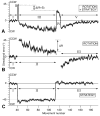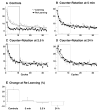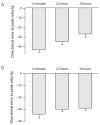Motor learning and consolidation: the case of visuomotor rotation
- PMID: 19227512
- PMCID: PMC2672910
- DOI: 10.1007/978-0-387-77064-2_21
Motor learning and consolidation: the case of visuomotor rotation
Abstract
Adaptation to visuomotor rotation is a particular form of motor learning distinct from force-field adaptation, sequence learning, and skill learning. Nevertheless, study of adaptation to visuomotor rotation has yielded a number of findings and principles that are likely of general importance to procedural learning and memory. First, rotation learning is implicit and appears to proceed through reduction in a visual prediction error generated by a forward model, such implicit adaptation occurs even when it is in conflict with an explicit task goal. Second, rotation learning is subject to different forms of interference: retrograde, anterograde through aftereffects, and contextual blocking of retrieval. Third, opposite rotations can be recalled within a short time interval without interference if implicit contextual cues (effector change) rather than explicit cues (color change) are used. Fourth, rotation learning consolidates both over time and with increased initial training (saturation learning).
Figures









Similar articles
-
Adaptation to visuomotor transformations: consolidation, interference, and forgetting.J Neurosci. 2005 Jan 12;25(2):473-8. doi: 10.1523/JNEUROSCI.4218-04.2005. J Neurosci. 2005. PMID: 15647491 Free PMC article. Clinical Trial.
-
Explicit contextual information selectively contributes to predictive switching of internal models.Exp Brain Res. 2007 Aug;181(3):395-408. doi: 10.1007/s00221-007-0940-1. Epub 2007 Apr 12. Exp Brain Res. 2007. PMID: 17437093
-
Explicit and implicit contributions to learning in a sensorimotor adaptation task.J Neurosci. 2014 Feb 19;34(8):3023-32. doi: 10.1523/JNEUROSCI.3619-13.2014. J Neurosci. 2014. PMID: 24553942 Free PMC article.
-
Motor learning and prediction in a variable environment.Curr Opin Neurobiol. 2003 Apr;13(2):232-7. doi: 10.1016/s0959-4388(03)00038-2. Curr Opin Neurobiol. 2003. PMID: 12744979 Review.
-
Human sensorimotor learning: adaptation, skill, and beyond.Curr Opin Neurobiol. 2011 Aug;21(4):636-44. doi: 10.1016/j.conb.2011.06.012. Epub 2011 Jul 20. Curr Opin Neurobiol. 2011. PMID: 21764294 Review.
Cited by
-
Facilitation of learning induced by both random and gradual visuomotor task variation.J Neurophysiol. 2012 Feb;107(4):1111-22. doi: 10.1152/jn.00635.2011. Epub 2011 Nov 30. J Neurophysiol. 2012. PMID: 22131385 Free PMC article.
-
Temporal visuomotor synchrony induces embodiment towards an avatar with biomechanically impossible arm movements.Iperception. 2023 Nov 7;14(6):20416695231211699. doi: 10.1177/20416695231211699. eCollection 2023 Nov-Dec. Iperception. 2023. PMID: 37969571 Free PMC article.
-
An explicit strategy prevails when the cerebellum fails to compute movement errors.Cerebellum. 2010 Dec;9(4):580-6. doi: 10.1007/s12311-010-0201-x. Cerebellum. 2010. PMID: 20697860 Free PMC article.
-
Analysis of the Effectiveness of Sub-sensory Electrical Noise Stimulation During Visuomotor Adaptations in Different Visual Feedback Conditions.Front Bioeng Biotechnol. 2019 Dec 6;7:399. doi: 10.3389/fbioe.2019.00399. eCollection 2019. Front Bioeng Biotechnol. 2019. PMID: 31921805 Free PMC article.
-
The effect of combining punishment and reward can transfer to opposite motor learning.PLoS One. 2023 Apr 10;18(4):e0282028. doi: 10.1371/journal.pone.0282028. eCollection 2023. PLoS One. 2023. PMID: 37036847 Free PMC article.
References
-
- Anderson MC, Bjork RA, Bjork EL. Remembering can cause forgetting: retrieval dynamics in long-term memory. J Exp Psychol Learn Mem Cogn. 1994;20(5):1063–87. - PubMed
-
- Brashers-Krug T, Shadmehr R, Bizzi E. Consolidation in human motor memory. Nature. 1996;382:252–255. - PubMed
-
- Cunningham HA. Aiming Error Under Transformed Spatial Mappings Suggests a Structure for Visual-Motor Maps. Journal of Experimental Psychology: Human Perception and Performance. 1989;15(3):493–506. - PubMed
Publication types
MeSH terms
Grants and funding
LinkOut - more resources
Full Text Sources
Other Literature Sources

